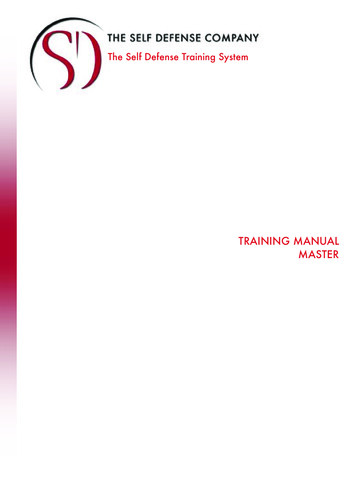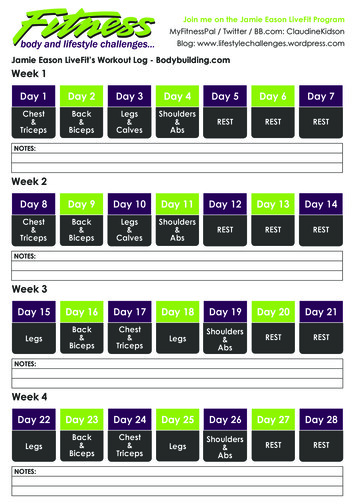
Transcription
Page 1UNC School of Social Work Clinical Institute Series2-Day Intensive Training inAcceptance and Commitment Therapy (ACT)April 17 & 18, 2015Presented by: Rhonda M. Merwin, PhDPeer-Reviewed ACT Trainer, Association of Contextual and Behavioral Science (ACBS)www.actatduke.orgOther Resources:www.contextualscience.orgSome materials contained here are available through membership in ACBS.www.actcarolinas.comTraining in Acceptance and Commitment Therapy – UNC School of Social Work Clinical Institute Series – April 2015
Page 2Accept – then act. Whatever the present moment contains, accept it asthough you had chosen it. -Eckhart TolleOverview of TrainingIn Day 1, we will use a combination of didactic and experiential learning methods to introducethe ACT model. Clinicians will learn the theoretical and philosophical underpinnings of ACTand practice conceptualizing cases from this perspective. They will be oriented to the 6 ACTprocesses (acceptance, defusion, present moment and self-as-context, and values and committedaction) that promote meaningful behavior change. Day 2 will focus on enhancing clinicians’flexibility and effectiveness in the domain of emotional experiencing. Clinicians will learn howacceptance is supported by the other ACT processes, and how to enhance clients’ willingness toexperience difficult emotions in the service of greater life vitality. Day 2 will rely heavily ondemonstration and practice, and “real” play.Tentative ScheduleDay 112:30-1:001:00-3:003:00-3:153:15-4:45Day 001:00-2:302:30-2:452:45-4:00Check inOverview of the ACT model and Case FormulationBreakPractice Case Formulation and Introduction to Core ProcessesCheck inCreating conditions for change (creative hopelessness/control is theproblem/willingness is the alternative)BreakRecontextualizing painful private experiences with values;Shaping broader patterns of acceptance and willingnessLunchFreeing clients from their thoughts (decreasing needless suffering anddefusing barriers to change)BreakStrengthening the observer self (separate from thoughts and feelings);Final discussionTraining in Acceptance and Commitment Therapy – UNC School of Social Work Clinical Institute Series – April 2015
Page 3Psychological FlexibilityThe ability to contact the present moment fully as a conscious human being and, givenwhat the environment affords, cease or persist in behaviors that would be effectivegiven deeply held, personal valuesComponents of the ityTraining in Acceptance and Commitment Therapy – UNC School of Social Work Clinical Institute Series – April 2015
Page 4The Willingness QuestionpsychologicalflexibilityTraining in Acceptance and Commitment Therapy – UNC School of Social Work Clinical Institute Series – April 2015
Page 5Basic Case Formulation 1 of 2Clients are taught to ACT:1. Accept2. Choose3. Take ActionBetween and within sessions:1. Choose (a valued direction)2. Move (committed action)3. Acceptance/Defusion (of thoughts/feelings that function as barriers)Training in Acceptance and Commitment Therapy – UNC School of Social Work Clinical Institute Series – April 2015
Page 6Basic Case Formulation 2 of 2Informed by historical and current context, in session behaviorA. Functional Classes1. Avoided EventsThoughts, feelings, body sensations, urges, memories, etc. that are evaluated as negative, unwanted, intolerable,feared and functionally related to problem behaviors 2. Avoidant RepertoireBegin with target behaviors as defined by the client or others; diagnosisInclude overt behavioral avoidance (avoidance of people, places, situations)Include overt behaviors that aim to change the form, frequency or intensity of a thought or feeling (e.g.,obvious, like using substances, and less so, like complying to minimize conflict)Include covert actions (e.g., planning, problem-solving, intellectualizing, worrying, etc.)Inaction is actionTraining in Acceptance and Commitment Therapy – UNC School of Social Work Clinical Institute Series – April 2015
Page 7B. Costs What has the individual lost b/c of avoidance and control?What has the individual not had the opportunity for b/c of avoidance and control?How much energy is expended in avoidance/control that could be invested in meaningful life activity?C. Barriers Beliefs of what is possible/not possibleHistory of control workingSense of deserving sufferingConcern for what “letting this go” would mean (who would be made right, how much time has been lost,what risks would have to be taken)Skill deficits (e.g., individual avoids conflict because lacks assertiveness skills; avoids emotions becauseunclear what they are feeling etc.)Other direct functions (e.g., financial incentives, increased care-taking from others)ExerciseConsider an issue that you struggle with most.What are the relevant thoughts and feelings?What is your posture with respect to these thoughts and feelings (are you holding tightly,pushing away)What does this look like (behaviorally)? or What do you do in response to these thoughts andfeelings?What is the short-term result? What are the long-term costs?ExerciseAre there some emotions that are easier for you than others? Why? What beliefs make thisemotion difficult? (beliefs fusion)When is the emotion most likely to show up? (in a valued context?)This is what I value This is what has been getting in the way of that This is what I commit to Training in Acceptance and Commitment Therapy – UNC School of Social Work Clinical Institute Series – April 2015
Page 8Feared futureRegretted pastStories of selfStrugglingwith PainValued vitalliving with PainI / Here / NowTraining in Acceptance and Commitment Therapy – UNC School of Social Work Clinical Institute Series – April 2015
Page 9ACT Advisor(Source: ACBS, modified)Training in Acceptance and Commitment Therapy – UNC School of Social Work Clinical Institute Series – April 2015
P a g e 10The ACT Matrix(Source: Polk, modified)Training in Acceptance and Commitment Therapy – UNC School of Social Work Clinical Institute Series – April 2015
P a g e 11Open to ExperienceThe best thing to do when it is raining is let it rain.- LongfellowNotice that the stiffest tree is the most easily crackedwhile the bamboo or willow survives by bending with thewind. –Bruce LeeYou can't stop the waves, but you can learn to surf. - JosephGoldsteinFear doesn't go away but you walk toward fear nakedand the gate opens. –Starhawk10Training in Acceptance and Commitment Therapy – UNC School of Social Work Clinical Institute Series – April 2015
P a g e 12Centered or AwareThe mystery of life is not a problem to be solved, but a realityto be experienced. -Zen SayingThe self must know stillness before it can discover it’s truesong. -UnknownOur one true home is in the present moment. — Thich Nhat HanhDo not look back in anger, or forward in fear, but around inawareness. - James Thurber10Training in Acceptance and Commitment Therapy – UNC School of Social Work Clinical Institute Series – April 2015
P a g e 13Engaged“Courage doesn’t always roar. Sometimes it is aquiet voice saying, ‘I will try again tomorrow.’” -MaryAnne RadmacherOur greatest glory is not in never failing, but in risingevery time we fall. — ConfuciusLive as if you were to die tomorrow. Learn as if youwere to live forever. — GandhiNotes:Core Competencies Involved in the Basic ACT Therapeutic StanceTraining in Acceptance and Commitment Therapy – UNC School of Social Work Clinical Institute Series – April 2015
P a g e 14(Source: ACBS, modified)Creating Conditions for ChangeDrawing out the system/creative hopelessness/control is theproblem/willingness is the alternativePurpose: To notice that there is a change agenda in place and notice the basic unworkability of that system; toname the system as inappropriately applied control strategies; to examine why this does not workMethod: Draw out what things the client has tried to make things better, examine whether or not they have trulyworked in the client’s experience, and create space for something new to happen.Things to avoid: Never try to convince the client: their experience is the absolute arbiter. The goal is not afeeling state; it is what the Zen tradition calls “being cornered.”Examples of techniques:What brought you into treatment?Person in the holeChinese handcuffsQuicksandTug of war with a monsterCloset full of stuffCards thrownClear out old to make room for newBreak down reliance on old agendaParadoxFeedback screech metaphorRule of private eventsFall in love, jelly doughnut, what arethe numbers?Two scales metaphorValues deflectionPolygraph metaphorBring into sessions sense of being stuck, strange loopsThe solution is unworkable, not the personThe way out is inMaximizing contact frees youThe harder you pull, the harder it pulls backYou have to work hard to keep the door closedAll your energy is investedField full of dead trees that need to be burned down for new trees togrow; garden with weedsOld, familiarConfusion means the possibility of something newIt's not the noise that is the problem, it’s the amplification“If you aren’t willing to have it, you’ve got it.”Illusion of control metaphorsWillingness vs. controlCosts of low willingnessWhen the stakes are high, control is even more difficultTraining in Acceptance and Commitment Therapy – UNC School of Social Work Clinical Institute Series – April 2015
P a g e 15Cognitive Defusion (Deliteralization)Purpose: To decrease over-attachment to the content of mental activity when it increases suffering or interfereswith effective action. To see thoughts as what they are, not as what they say they are.Method: Structure seeing the process of thinking, notice the automaticity and the ease of programming, thearbitrary nature of content and the overextension of the mind into areas of life where it is not helpful. Interactwith thoughts in ways other than literal. Create a stance of mindful observation and let experience be the guide.Things to Avoid: Relying on didactic rather than experiential methods (i.e., telling clients what defusion israther than creating a context in which they can experience defusion). Evaluating thoughts as logical/illogical,rational/irrational, or true/untrue (directly or subtly). The only measure is “workability” of the actions that thethoughts would dictate. Poor timing will be a therapeutic “miss.”Examples of techniques‘The Mind”Mental appreciationCubbyholing“I’m having the thought that ”Just noticing“Buying” or “hooked by”thoughtsTitchener’s repetitionPhysicalizingMake an objectLeaves on a stream (or similar)Bad news radioFocused mindfulnessSound it outSing it outSilly voicesExperiential seekingPolaritiesArrogance of wordThink the oppositeYour mind is not your friendWho would be made wrong bythat?Thoughts are not causesChoose being right or choosebeing aliveThere are four people in hereMonsters on the busWho is in charge here?Treat “the mind” as an external event; almost as a separate personThank your mind; show aesthetic appreciation for its productsLabel private events (kind or function)Employ language conventions that differentiate the “I” from the thoughtor feelingUse the language of observation when talking about thoughtsUse active language to empower choice or highlight the issue is how onerelates to the thought; also distinguishes thoughts and beliefsRepeat the difficult thought until you can hear itDescribe the physical dimensions of thoughtsSit next to the client and put each thought and experience out in front ofyou both as an objectWatching thoughts without involvementPlay an announcerDirect attention to nonliteral dimensions of experienceSay difficult thoughts very, very slowlySing your thoughts (or make up poetry)Say your thoughts in other voices – Charlie brown’s teacherOpenly seek out more material, especially if it is difficultStrengthen the evaluative component of a thought and watch it pull itsoppositeTry to instruct nonverbal behaviorEngage in behavior while trying to command the oppositeSuppose your mind is mindless; who do you trust, your experience oryour mindIf a miracle happened and this cleared up without any change in (listreasons), who would be made wrong by that?“Is it possible to think that thought, as a thought, AND do x?”If you have to pay with one to play for the other, which do you choose?Open strategize how to connect when minds are listeningTreating scary private events as monsters on a bus you are drivingTreat thoughts as bullies; use colorful languageTraining in Acceptance and Commitment Therapy – UNC School of Social Work Clinical Institute Series – April 2015
P a g e 16Carry baggageTake your mind for a walkHow old is this?And what is that in the service of?OK, you are right. Now what?Mary had a little .Get off your butsWhat are the numbers?Why, why, why?Create a new storyFind a free thoughtDo not think “x”Find something that can’t beevaluatedRepresents conceptualized historyWalk behind the client chattering mind talk while they choose where towalkStep out of content and notice at the process level how long thoughtshave hung around, etc.Step out of content and ask this questionTake “right” as a given and focus on actionSay a common phrase and leave out the last word; link to automaticityof thoughts the client is struggling withReplace virtually all self-referential uses of “but” with “and”Teach a simple sequence of numbers and then (playfully) harass theclient regarding the arbitrariness and yet permanence of this mentaleventShow the shallowness of causal explanations by repeatedly asking“why”Write down the normal story, then repeatedly integrate those facts intoother storiesAsk client to find a free thought, unconnected to anythingSpecify a thought not to think and notice that you doLook around the room and notice that every single thing can beevaluated negativelyTraining in Acceptance and Commitment Therapy – UNC School of Social Work Clinical Institute Series – April 2015
P a g e 17AcceptancePurpose: Allow yourself to have whatever inner experiences are present when doing so foster effective action.Method: Reinforce approach responses to previously aversive inner experiences, reducing motivation to behaveavoidantly (altering negatively reinforced avoidant patterns).Things to avoid: Gritting teeth/white knuckling, passive saying “yes” to experience (acceptance is active),resignation. Remember to titrate accordingly. Poor timing will be a therapeutic “miss.”Examples of techniques (techniques from creating conditions of change are also acceptance building)Observing emotional wavesWatch emotion rise and fall naturally; stand on the beach rather than surfthe waveControl is the problemUnworkability (rule of private events); traumatic deflection (distractsand derails)Card fileClient pulls “cards” of memories of previous times in which he wasavoidant. Imagines it stretching into the future. What if it were to go justlike this ”Cards thrown (or tug of war)Cards with unwanted thoughts/feelings are thrown at the client whilethey try to “keep them away.” Illustrates energy invested; what is it liketo let your hands be free? What would you do if they were free?Experiential awarenessLearn to pay attention to internal experiences, and to how we respond tothemA gem, a baby, a treasurePainful feelings are described as something treasured/valued/held gentlyTwo-sided coinLeaning down the hillAmplifying experienceIn vivo exposureThe Serenity PrayerCarry your keysCarry cardsPost ItPhysicalizingMake spaceAcceptance homeworkDiscrimination trainingPainful feelings and values are inexplicably tied, you can’t toss onewithout tossing the otherChanging the response to material – toward the fear not awayBring into awareness, allow it to growStructure and encourage intensive experiencing in session; blockavoidant behavior that shows upGrant me the serenity to accept the things that I cannot change .Assign difficult thoughts and experiences to the clients’ keys. Ask theclient to think the thought as a thought each time the keys are handled,and then carry them from thereWrite difficult thoughts on 3 x 5 cards and carry them into the day –read them at times when it is most difficult (but most likely) to havethemPost difficult thoughts/feelings up on the wall so that they can be seenand be experienced as part of the landscapeDescribe feeling like object w/ properties (bumpy, spiky, heavy, black),interacting with feelings as something separate from the self that can beobservedMake space for a difficult thought or feeling in the body (releasingtension, full belly breathing) or in the room (give it a chair)Go out and find itTeach clients to identify avoidance in the moment and discriminate fromacceptance postureTraining in Acceptance and Commitment Therapy – UNC School of Social Work Clinical Institute Series – April 2015
P a g e 18JournalingTin Can Monster ExerciseDistinguishing between clean anddirty emotionsDistinguishing willingness fromwantingJoe the bumDistinguishing willingness theactivity from willingness thefeelingChoosing Willingness: TheWillingness QuestionTwo scales metaphorCaution against qualitativelylimiting willingnessDistinguish willing fromwallowingChallenging personal space:Practice relating differentlyUse unexpected language(opposite of avoidance/control)Practice acceptancePractice noticingSystematically explore dimensions of a difficult overall eventTrauma pain unwillingness to have painWilling to have something is not the same as wantingInviting in all experiences (even the bum you don’t want to come to theparty)Opening up is a behavior—different from feeling like itGiven the distinction between you and the stuff you struggle with, areyou willing to have that stuff, as it is and not as what it says it is, and dowhat works in this situation?Focus on what can be changed; let go of what cantThe tantruming kid metaphor – if a kid knew your limits he’d trantrumexactly that long; Jumping exercise – you can practice jumping from abook or a building, but you can step down only from the book – don’tlimit willingness qualitativelyMoving through a swamp metaphor: the only reason to go in is becauseit stands between you and getting to where you intend to goSitting eye to eyeMake a feeling an object in the room – explore and practice varyingpostures with respect to it (gently on the lap?)“beautiful! Love it” in response to painful emotionsStay with a difficult topic- gently redirect back when the mind tries to“save” the person; also block “collapsing” into the emotion (fusion)Training in Acceptance and Commitment Therapy – UNC School of Social Work Clinical Institute Series – April 2015
P a g e 19Self-as-ContextPurpose: Make contact with a sense of self that is a safe and consistent perspective from which to observe theinner and outer worldMethod: Noticing the person who is noticing, connecting to the continuity of consciousness, separating the “I”from the content, categories or caricaturesThings to avoid: Relying too heavily on didactic rather than experiential teaching and knowing. Per usual, noresorting to convincing the client.Examples of techniquesObserver exerciseMeditationsMetaphors that illustrate self asdistinct from thoughts/feelingsetc.Identifying content as contentTwo computers exerciseProgramming processProcess vs outcome“I am ”Conceptualized selfOthers as objectsConnecting at “board level”Getting back on the horseContrast observer self withconceptualized selfForgivenessTherapeutic relationship“Confidence”Notice who is noticing in various domains of experienceMountain meditation; you are the mountain not the seasonsBox with stuff; house with furniture; chessboard; clouds in the sky;waves and the ocean floorSeparating out what changes and what does notIdentify programmingContent is always being generated – generate some in session togetherPractice resting in the present from thoughts of the future/pastYou are not anything of those things, you are the INotice how stories (good or bad) narrow us in some contextsRelationship vs being rightPractice being a human with humansConnecting to the fact that they will always move in and out ofperspective of self-as-context, in session and outPick an identity exerciseIdentify painful experiences as content; separate from contextModel unconditional acceptance of the clientcon with; fidence fidelity or faith – self fidelityTraining in Acceptance and Commitment Therapy – UNC School of Social Work Clinical Institute Series – April 2015
P a g e 20ValuingPurpose: To establish a compass to guide patterns of purposeful activity over long periods of time. To findpurpose that dignifies pain.General Method: Help clients choose and declare what gives life meaning/vitality (even when painful) andwhat they want to “be about.” (how they want to pattern their lives). Help clients identify what they would bewilling to experience discomfort for. Distinguish values from goals and values from reasoned actions; Linkactivity to values.Examples of values techniquesCoke versus 7-UpTombstoneEulogyValues clarification exerciseGoal clarificationAction specificationBarrier clarificationTaking a standSwitchback metaphorGPSTraumatic deflectionPick a game to playProcess / outcome and valuesSkiing down the mountainmetaphorPoint on the horizonChoosing not to chooseResponsibilityWhat if no one could know?Sticking a pen through your handThe little kidLighthouses/compassesThe choiceValues expressionDefine choice and have the client make a simple one. Then ask why? Ifthere is any content based answer, repeatHave the client write what he/she stands for on his/her tombstoneWrite your eulogy. What do you want to be the story of your life?Author values in major life domains and assess consistency of behaviorwith those valuesList concrete goals that would instantiate these valuesList concrete actions that would lead toward these goalsList barriers to taking these actionsStand up and declare a value without avoidanceThe twists and turns are not the directionThe most scenic or pleasant route, or where you actually want to go?What value could you live if pain did not throw you off course?Define a game as “pretending that where you are not yet is moreimportant than where you are” -- define values as choosing the game“Outcome is the process through which process becomes the outcome”If a helicopter flew you down it would not be skiingPicking a point on the horizon is like a value; heading toward the tree islike a goalYou cannot avoid choice because no choice is a choiceYou are response-ableImagine no one could know of your achievements: then what would youvalue?Can I do this? Can I do this if it means that someone close to you willnot get cancer in the next year? We are willing to endure pain forsomething meaningfulBring back the client at an earlier age to ask the adult for somethingIllustrates values as providing directionYou can take away your [pain], you can never feel X again, but youhave to give up [value] OR your can have your [pain] and theopportunity for [value]. Which do you choose?Finding ways to express your values in daily lifeTraining in Acceptance and Commitment Therapy – UNC School of Social Work Clinical Institute Series – April 2015
P a g e 21Training in Acceptance and Commitment Therapy – UNC School of Social Work Clinical Institute Series – April 2015
P a g e 22What needs to be acceptedAcceptance is different from liking or wanting. It is also not resignation or “giving in,” but rather be willing toexperience something in order to live more fully and consistently with values.The thoughts, memories or images that I would have to accept in order to move forward:.The emotions that I would have to accept in order to move forward:The body sensations, urges, or behavioral predispositions that I would have to accept in order to moveforward:Training in Acceptance and Commitment Therapy – UNC School of Social Work Clinical Institute Series – April 2015
P a g e 23Day/TimeSituationResponse(e.g., thoughts, feelings,body sensations, urges,memories etc.)(clean suffering)Extent to which youstruggled with yourthoughts and feelings(0 not at all, 10 very much).OutcomeWays in which youstruggled? This mightinclude overt behaviors(e.g., drinking) as wellas covert behaviors(e.g., telling yourselfyou are stupid forfeeling that way). (dirtysuffering)Training in Acceptance and Commitment Therapy – UNC School of Social Work Clinical Institute Series – April 2015
P a g e 24Mountain Meditation(Source: Wherever You Go, There You Are by Jon Kabat-Zinn, modified)Posture, awareness of sitting, breathing, grounded Now bringing to mind a beautiful mountain you know of or can imagine. Focusing on the image or the feelingof the mountain in your mind’s eye, noticing its overall shape the lofty peak the base rooted in solidrock . the sloping sides. Noting how massive it is, how unmoving, how beautiful whether seen from far awayor up close.Now sitting and breathing with the image of this mountain, observing it, noticing its qualities. And seeing if youcan bring the mountain into your own body so that your body sitting here and the mountain in your mindbecome one Your head becomes the lofty peak; your shoulders and arms the sides of the mountain; yourbuttocks and legs the solid base rooted to your cushion on the floor or to the chair. Experiencing in your bodythe sense of uplift, the elevated quality of the mountain deep in your own spine. Inviting yourself to become abreathing mountain, unwavering in your stillness, completely what you are—beyond words and thought acentered, rooted, unmoving presence.As we all know, throughout the day as the sun travels the sky, the mountain just sits. Even the untrained eye cansee changes by the hour As the light changes, as night follows day and day night, the mountain just sits,simply being itself. It remains still as the seasons flow into one another and as the weather changes moment bymoment and day by day. Calmness through all the change.Change occurring season by season. Snow comes and goes. In any season, the mountain may at times beenshrouded in clouds or fog, or pelted by freezing rain. It’s all the same to the mountain. In sun or clouds,broiling or frigid, it just sits, being itself. At times visited by violent storms, buffeted by snow and rain andwinds of unthinkable magnitude, through it all, the mountain sits. Spring comes, the birds sing in the treesagain, leaves return the trees which lost them, flowers bloom in the high meadows and on the slopes, streamsoverflow with waters from melting snow. Through it all, the mountain continues to sit, unmoved by theweather, by what happens on the surface, by the world of appearances.As we sit holding this image in our minds, we can embody the same unwavering stillness and rootedness in theface of everything that changes in our own lives over seconds, hours, and years. In our lives and in our practice,we constantly experience the changing nature of the body and of the mind and of the outer world. Weexperience periods of light and dark, vivid color and drab dullness. We experience storms of varying intensityand violence, in the out world and in own lives and minds. Buffeted by the high winds, by cold and rain, weendure periods of darkness and pain. We savor moments of joy and uplift.By becoming the mountain, we link up with its strength and stability and adopt them for our own. We use themountain’s energy to support our efforts to encounter each moment with mindfulness, equanimity, and clarity.It may be helpful to see that our thoughts and feelings, our preoccupations, our emotional storms and crises,even the things that happen to us are more like the weather on the mountain. We tend to take it personally but itis actually impersonal. The weather of our own lives is not to be ignored or denied. Rather, it is to beencountered, honored felt known for what it is, and held in high awareness. In holding it this way we cometo know a deeper silence and stillness and wisdom than we may have thought possible, right in the middle of thestorms.Training in Acceptance and Commitment Therapy – UNC School of Social Work Clinical Institute Series – April 2015
P a g e 25Valued Living Questionnaire(source: Wilson, modified)Deep down inside, what is important to you? What do you want your life to stand for? Values are our heart’sdeepest desires for the way we want to interact with and relate to the world, other people and ourselves. Theycan guide us as we move through life.Values are not the same as goals. Values are directions that we keep moving in, whereas goals are achievedalong the way. A value is life heading north. A goal is like going to Wisconsin. Goals are checked off a list.Values are not satiated, and may guide our behavior over a life time.The following are areas of life that are valued by some people. Not everyone has the same values, and this is nota test to see whether you have the “correct” values. Think about each area in terms of general directions, notspecific goals. There may be certain areas that you don’t value much and you can skip them if you wish. Therealso might be areas of overlap, and that’s okay too. It is important that you write down what you would value ifnothing got in your way. What’s important? What do you care about? What do you want to be about in a worldwhere you could freely choose?For each of the 10 domains, write a few words to summarize your valued direction (it might be helpful to beginwith the stem: “I want to be a person who ”). Rate how important this value is to you on a scale from 0 (lowimportance) to 10 (high importance). It’s okay to have several values scoring the same number. Rate howsuccessfully you have lived this value during the past month on a scale from 0 (not at all successfully) to 10(very successful
Training in Acceptance and Commitment Therapy - UNC School of Social Work Clinical Institute Series - April 2015 Accept - then act. Whatever the present moment contains, accept it as though you had chosen it. -Eckhart Tolle Overview of Training In Day 1, we will use a combination of didactic and experiential learning methods to introduce

![Welcome [dashdiet.me]](/img/17/30-day-weight-loss-journal.jpg)









